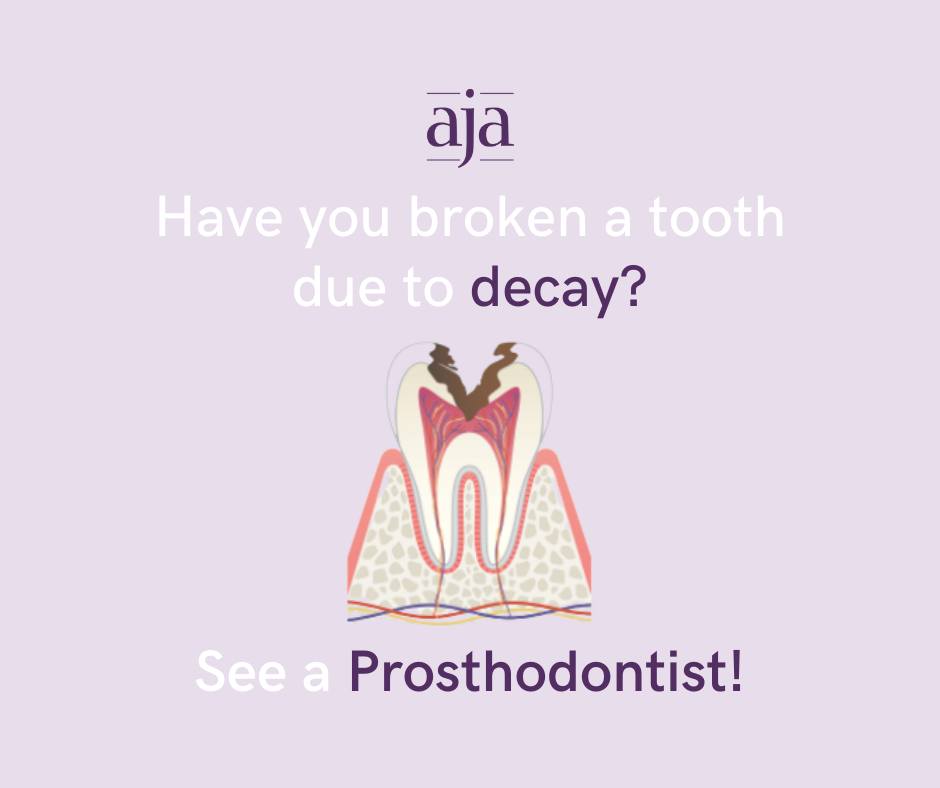Have a broken tooth? A Prosthodontist can fix that.
Have you ever broken a tooth?
If so, don’t worry, you’re not the only one.
In honor of National Prosthodontics Awareness Week (NPAW), I want to go over a few reasons why teeth break, describe some of the options available for treatment and how a prosthodontist is uniquely qualified to diagnose and treat broken teeth.
First, let’s define what a prosthodontist is.
A prosthodontist is a dental specialist with several years of advanced training beyond dental school, who focuses on the restoration and replacement of damaged teeth and other oral or facial issues.
There are many different causes of broken teeth that prosthodontists see on a daily basis. Which include…
Bruxism
Bruxism is a condition that encompasses the involuntary grinding and clenching of teeth. Oftentimes, bruxism occurs because of increased stress, and it usually happens without you even realizing it (typically during sleep). Without intervention, it wears down the teeth and can cause them to chip along the edges. In severe cases, it can even fracture the tooth down to the root!
Accident or Injury
More often than not, broken teeth occur as a result of an accident or injury to the face and/or mouth. Sometimes the damage is minimal and other times it requires thorough procedures across several specialties of dentistry. A prosthodontist is able to work with a team of dental professionals to ensure you receive the proper care for your dental trauma.
Decay or Caries
When an area of decay in a tooth gets large enough, it can undermine the existing tooth structure or filling, and break off. Cavities exist even when there’s no pain, so it’s important to visit your dentist regularly for checkups! Prosthodontists in particular are specialists in the replacement of missing tooth structure, so they’re the perfect specialist to see for advanced damage to teeth due to decay.
Now that we know some of the causes of broken teeth, let’s go over common treatment options.
Inlays, onlays, veneers & crowns
If a large part of a tooth is broken or the remaining healthy tooth structure is not sufficient, a restoration such as an inlay, onlay, veneer, or crown may be an appropriate treatment. These restorations are fabricated in a dental laboratory and as prosthodontists, we receive extra training in communication with our laboratory counterparts.
Inlay - An inlay is used when a cavity is too large for a routine filling. The inlay is fabricated as a single solid piece that fits perfectly within the shape of the cavity itself and is cemented in place.
Onlay - Similar to an inlay, an onlay is a piece that covers the cusp of a broken tooth as well as its side and is sometimes referred to as a “partial crown.”
Veneer - This is a tooth shaped porcelain shell that adheres to the front surface of a tooth.
Crown - A crown is more a tooth replacement than a repair. After all existing decay is removed from a tooth, a cap fashioned in the shape of a tooth is secured on top of whatever remains of the tooth.
Implants & dentures
Unfortunately, there are times when an injury to a tooth is so severe that it cannot be restored. In these circumstances, the tooth will need to be extracted. Options for replacement include an implant, a fixed bridge, or a removable prosthesis like a complete or partial denture.
Implant - unlike a crown, the tooth is extracted completely and an implant is fused into the bone of the jaw with a porcelain tooth cemented on top of it.
Fixed bridge - a partial denture that is secured permanently in the mouth by being cemented to the adjacent teeth or roots.
Partial denture - A partial denture is a group of porcelain teeth that are fused together and secured between remaining teeth. Unlike a fixed bridge, partial dentures are molded with grooves that fit snugly against the adjacent teeth, so that they can be removed when necessary.
Complete denture - These are very similar to a partial denture, except they replace an entire row of upper or lower teeth instead of a group/section of teeth.
In conclusion…
For all your restorative dental needs, prosthodontists are here to ensure that your smile is healthy, functional and beautiful. If you have a broken tooth and would like an opinion on the best treatment option for you, feel free to contact us here for a consultation with me today!






